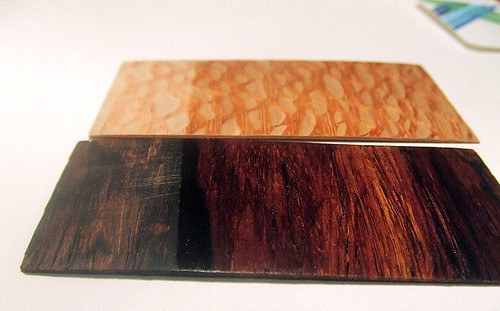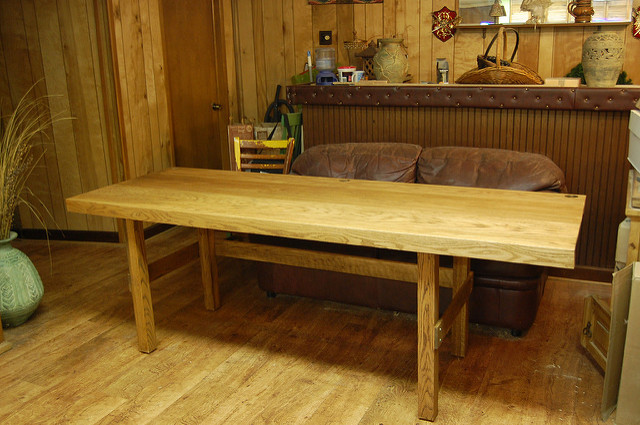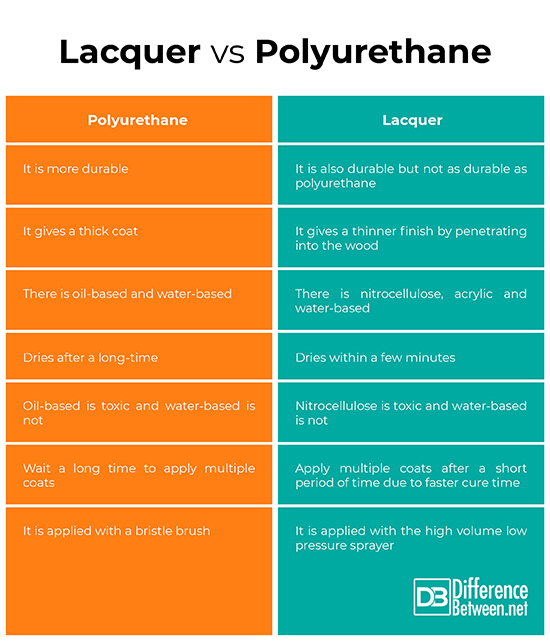Difference Between Polyurethane and Lacquer
Polyurethane and lacquer are two of the common wood finishes used to add a smooth and glossy coat. The other closely-linked finishes include shellac and varnish. Polyurethane and lacquer are oftentimes used interchangeably mainly due to the confusion of their identities. There is a significant difference between these finishes, and this article unfolds that.

What is lacquer?
Lacquer is a common wood furniture finish preferred by woodworkers among other finishes. This has to do with its ease of applications and quick-dry as it is a thinner finish. It provides a smooth and glossy finish while remaining durable on the wood. Again, it is resistant to damages as it penetrates the wood surface. Applying lacquer requires a high-volume, low-pressure sprayer in an adequately ventilated room.
There are basically three lacquer variances, viz. acrylic lacquer, water-based lacquer and nitrocellulose lacquer. Irrespective of these variances, lacquer is generally durable and quick-drying.
- Acrylic lacquer – Acrylic lacquer is well-known for its resistance to causing yellow color on wood finishes as others do. Instead, it leaves a clear color. Among other types of acrylic lacquers, there is the CAB-acrylic lacquer – a finish that is less brittle and more flexible. It is furthermore resistant to wear and scratches. However, it is costly. Applying this finish requires the spray if you combine it with a thinner agent.
- Water-based lacquer – this lacquer finish is less toxic, odorless and more durable than other oil-based finishes. Comparing it with nitrocellulose, it can last for an extra period of 5 years. It also dries faster and costs lesser.
- Nitrocellulose lacquer – the finish is characterized by its evaporative property. It was first used on automobiles and later found its way to wood furniture. It enhances the color, and so it can be used on light or dark wood furniture. Moreover, it is resistant to damages while giving your wood surface a protective film. Nitrocellulose lacquer should be applied with caution as it is highly flammable. It requires a well-ventilated room. Also, do not overspray it.
If lacquer requires repairs, it is easy to accomplish that because it is thin and thus blends effectively with previous coats. Polyurethane, on the other hand, may require sanding to enhance adherence of successive coats applied.

What is polyurethane?
Polyurethane is also a popular wood finish applied to provide a thick and glossy finish. It is basically a plastic in a liquid form until it dries. Polyurethane, unlike lacquer, is thick and not easy to apply with the spray unless a thinning agent is combined with it. The finish comes in water-based and oil-based. These variances typically differ in the dry time and composition, but are commonly durable.
Water-based polyurethane
The water-based polyurethane is less toxic and odorless. It leaves no yellowish color on the wood surface and dries relatively faster than the oil-based counterpart. However, a water-based polyurethane does not withstand heat well. As a result, the finish is not best-suited for kitchen tabletop. Instead, it can work well on desks, bookcases, and other wood surfaces that are not exposed to extreme heat.
There is also a water-modified polyurethane that carries both the properties of oil-based and water-based polyurethanes. Minwax Polycrylic is one example of a composite of water-based and oil-based polyurethane. It is more durable than water-based ones. Applying it requires a synthetic bristle brush, rag or a foam roller. The product can be best-suited for wooden floors.
Oil-based polyurethane
This one carries the identity of polyurethane finishes. It is durable but dries slower. It can take up to 24 hours to dry hence professional woodworkers often prefer lacquer or water-based polyurethane over the oil-based one. However, the oil-based polyurethane is more durable than water-based ones. And, it can withstand heat abuse, and so using it on kitchen tabletop is the best strategy.
The oil-based polyurethane imparts odor and it is toxic. Users need to use it in an adequately ventilated environment. The downside of it is that it cures after a long time. Once it is applied incorrectly, it has to be sanded because successive coats will not adhere firmly to the previous one. Unlike the lacquer finish, polyurethane does not penetrate the wood. It only gives a surface coat that is durable. The other downside is that the oil-based one can leave a yellowish color on light wood products.
Because of its thickness, polyurethane is rarely applied with the spray unless a thinner is added to it. It needs a natural bristle brush.
Key differences between lacquer and polyurethane
Quality
Despite being available in variances, polyurethane is more durable. It is thick and leaves a strong coating. Lacquer is thin and penetrates the wood surface. It is also durable but susceptible to scratches and discoloration after some time.
Ease of application
Polyurethane is thicker and needs a brush to apply it. There could be some brush marks on your surface after applying it. You need a fine brush to prevent that. With the lacquer, you need the high volume low pressure sprayer to spray it on your target. It applies evenly even though the spray is expensive than the brush. So, in comparison, it is easier to apply lacquer than it is with polyurethane.
Dry time
Polyurethane takes longer to dry out. Within polyurethane variances, the water-based dries faster than the oil-based polyurethane. Lacquer dries quickly hence it is preferred by many woodworkers. It can dry within 10 minutes whereas polyurethane can take many hours to dry. Because of this quicker drying time, it is easy to apply multiple coats using lacquer than it is with polyurethane.
Multiple coats
It is easy to apply multiple coats with lacquer. Polyurethane, however, requires more time for it to cure and then sanding for the multiple coats to adhere firmly.
Lacquer Vs. Polyurethane

Summary of Lacquer Vs. Polyurethane
- Polyurethane is thicker than lacquer and dries after a long time
- Lacquer is thinner and dries quicker
- Polyurethane is available in water-based and oil-based whereas lacquer is available in acrylic, nitrocellulose and water-based
- Lacquer is easy to apply multiple coats because it dries quicker and the coats adhere to each other easily
- Polyurethane coat needs sanding for multiple coats
- Lacquer is applied with the high pressure low pressure sprayer whereas polyurethane is applied with the bristle brush. If a thinner is added, polyurethane can be applied with the spray too
- These finishes are both durable but polyurethane is more durable.
- Difference Between CBD and Indica - April 22, 2019
- Difference Between Unilateral Contract and Bilateral Contract - February 8, 2019
- Difference Between Polki and Kundan - December 15, 2018
Search DifferenceBetween.net :
1 Comment
Leave a Response
References :
[0]Michael Presutti (22 July 2009). The pros and cons of lacquers and polyurethane. Accessed at: https://www.silive.com/homegarden/homeimprovement/index.ssf/2009/07/the_pros_and_cons_of_lacquers.html. Accessed on 12 August 2018.
[1]Bob Flexner (2010). Understanding Wood Finishing: How to Select and Apply the Right Finish. Fox Chapel Publishing Company.
[2]Image credit: https://www.flickr.com/photos/dbarsky/2098764975
[3]Image credit: https://www.flickr.com/photos/jvree/378974210

I refinish guitars. Hobby. Can I rattlecan spray a guitar with Rustoleum which I THINK is polyurethane and then follow up with Krylon triple thick glaze as clearcoat? I THINK the Krylon is lacquer. The darn cans DO NOT identify contents as lacquer or polyurethane. That ignorant oversight is a huge problem when selecting paint products!!!